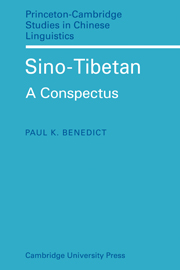Book contents
- Frontmatter
- Foreword
- Contents
- Preface
- Abbreviations
- 1 Introduction
- 2 Taxonomy (general)
- 3 Taxonomy (Sino-Tibetan)
- 4 Tibeto-Burman classification
- 5 Tibeto-Burman reconstruction (history)
- 6 Tibeto-Burman primary sources
- 7 Tibeto-Burman consonants (general; final)
- 8 Tibeto-Burman consonants (initial)
- 9 Tibeto-Burman consonant clusters
- 10 Tibeto-Burman vowels (finals; diphthongs)
- 11 Tibeto-Burman vowels (medials)
- 12 Tibeto-Burman tones
- 13 Tibeto-Burman morphology (history)
- 14 Tibeto-Burman morphology (categories)
- 15 Tibeto-Burman pronouns
- 16 Tibeto-Burman numerals
- 17 Tibeto-Burman morphology and syntax (general)
- 18 Tibeto-Burman affixes (special)
- 19 Tibeto-Burman affixes (general)
- 20 Tibeto-Burman dental suffixes
- 21 Tibeto-Burman prefixes (general)
- 22 Tibeto-Burman prefixed *s-
- 23 Tibeto-Burman prefixed *r-
- 24 Tibeto-Burman prefixed *b-
- 25 Tibeto-Burman prefixed *g-
- 26 Tibeto-Burman prefixed *d-
- 27 Tibeto-Burman prefixed *m-
- 28 Tibeto-Burman prefixed *a-
- 29 Tibeto-Burman alternation (consonantal, vocalic)
- 30 Karen (general)
- 31 Karen morphology (categories) and syntax
- 32 Karen pronouns
- 33 Karen numerals
- 34 Karen prefixes
- 35 Karen initial consonants and clusters
- 36 Karen final consonants and medial vowels
- 37 Karen final vowels and semi-vowels
- 38 Karen tones
- 39 Chinese (general, history)
- 40 Chinese morphology (prefixes, suffixes, alternation)
- 41 Chinese pronouns
- 42 Chinese numerals
- 43 Chinese phonology (history)
- 44 Chinese consonants (initials, finals)
- 45 Chinese consonant clusters
- 46 Chinese vowels and diphthongs
- 47 Chinese tones
- 48 Résumé (Chinese)
- Appendix I Tibeto-Burman roots
- Appendix II English–TB index
- Appendix III Primary Tibeto-Burman sources
- Appendix IV Author's and editor's bibliography
19 - Tibeto-Burman affixes (general)
Published online by Cambridge University Press: 10 November 2010
- Frontmatter
- Foreword
- Contents
- Preface
- Abbreviations
- 1 Introduction
- 2 Taxonomy (general)
- 3 Taxonomy (Sino-Tibetan)
- 4 Tibeto-Burman classification
- 5 Tibeto-Burman reconstruction (history)
- 6 Tibeto-Burman primary sources
- 7 Tibeto-Burman consonants (general; final)
- 8 Tibeto-Burman consonants (initial)
- 9 Tibeto-Burman consonant clusters
- 10 Tibeto-Burman vowels (finals; diphthongs)
- 11 Tibeto-Burman vowels (medials)
- 12 Tibeto-Burman tones
- 13 Tibeto-Burman morphology (history)
- 14 Tibeto-Burman morphology (categories)
- 15 Tibeto-Burman pronouns
- 16 Tibeto-Burman numerals
- 17 Tibeto-Burman morphology and syntax (general)
- 18 Tibeto-Burman affixes (special)
- 19 Tibeto-Burman affixes (general)
- 20 Tibeto-Burman dental suffixes
- 21 Tibeto-Burman prefixes (general)
- 22 Tibeto-Burman prefixed *s-
- 23 Tibeto-Burman prefixed *r-
- 24 Tibeto-Burman prefixed *b-
- 25 Tibeto-Burman prefixed *g-
- 26 Tibeto-Burman prefixed *d-
- 27 Tibeto-Burman prefixed *m-
- 28 Tibeto-Burman prefixed *a-
- 29 Tibeto-Burman alternation (consonantal, vocalic)
- 30 Karen (general)
- 31 Karen morphology (categories) and syntax
- 32 Karen pronouns
- 33 Karen numerals
- 34 Karen prefixes
- 35 Karen initial consonants and clusters
- 36 Karen final consonants and medial vowels
- 37 Karen final vowels and semi-vowels
- 38 Karen tones
- 39 Chinese (general, history)
- 40 Chinese morphology (prefixes, suffixes, alternation)
- 41 Chinese pronouns
- 42 Chinese numerals
- 43 Chinese phonology (history)
- 44 Chinese consonants (initials, finals)
- 45 Chinese consonant clusters
- 46 Chinese vowels and diphthongs
- 47 Chinese tones
- 48 Résumé (Chinese)
- Appendix I Tibeto-Burman roots
- Appendix II English–TB index
- Appendix III Primary Tibeto-Burman sources
- Appendix IV Author's and editor's bibliography
Summary
The prefixes and suffixes (apart from those used with numerals) of the reconstructed TB speech are listed below. In modern TB languages the prefixes normally have reduced stress and the neutral ∂ type of vocalization. Thus, the form written *g- is to be interpreted as *g∂ (with ∂ as a separate phoneme) or as gǎ (with ǎ an allophone of the phoneme /a/ in syllables with reduced stress). The vowel of the prefix is affected by vocalic harmony in several groups, notably Bodo-Garo and Mikir; cf. Dimasa gabaŋ ‘much’, gosoŋ ‘steep’, gusum ‘blue’, gepher ‘flat’, gimin ‘ripe’.
Suffixed *-s: original function uncertain; often reflexive in verb roots.
Suffixed *-t and *-n: original function uncertain; sometimes used in deriving nouns from verb roots; also causative or directive.
Prefixed *s-: causative, directive, or intensive with verb roots; often stands for TB *sya ‘flesh; animal’ in noun roots.
Prefixed *r-: both in verb and noun roots; function unknown.
Prefixed *b-: perhaps pronominal in some roots, but function generally unknown.
Prefixed *g-: rare; function unknown.
Prefixed *d-: rare; function unknown.
Prefixed *m-: pronominal in noun roots; intransitive in verb roots.
- Type
- Chapter
- Information
- Sino-TibetanA Conspectus, pp. 97Publisher: Cambridge University PressPrint publication year: 1972



